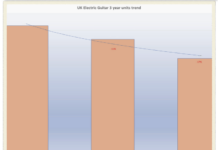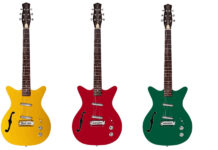
Three Easy Steps to Creating Killer Arpeggio Licks
Improvising with arpeggios is a great way to dig into chord changes, bringing out the exact sound of each chord in your lines. While scales and modes are great for outlining keys and creating modal colors, when you want to sound each chord in a progression, arpeggios are the way to go. While they are great for outlining chord changes, arpeggios can often become boring or predictable when you overuse them in a solo.
Improvising with arpeggios is a great way to dig into chord changes, bringing out the exact sound of each chord in your lines.
While scales and modes are great for outlining keys and creating modal colors, when you want to sound each chord in a progression, arpeggios are the way to go.
While they are great for outlining chord changes, arpeggios can often become boring or predictable when you overuse them in a solo. But while they can be bland if played as is, there are plenty of techniques that you can explore in order to create killer licks with these important, four-note groups. One of the easiest ways to expand any arpeggio is to add chromatic approaches above or below each note in the scale.
In this article, we will explore this concept, learning it from a technical standpoint and then creating licks that you can take into your solos. Before we start, I have used a G7 arpeggio for each example in the article. If you are new to this fingering, take a minute to check it out below and get it under your fingers before moving to the subsequent exercises.

Step 1: Chromatic Approach From Below
Once you have your fingers around the G7 arpeggio, you’re ready to dig into the first chromatic approach technique. This concept is fairly simple. Play the arpeggio while adding one chromatic approach below each note in that fingering. In the case of G7 you would get the following notes: F#-G A#-B C#-D E-F You can see this exercise written out below, with the chromatic approaches labeled “C” below each note. When you have this pattern under your fingers, take it to different keys, different arpeggios (Maj7, m7, m7b5, etc.) as well as to any one or two-octave arpeggio fingering you know or are working on in the practice room.

Step 2: Chromatic Approach From Above
The next step is to add one chromatic note above each of the notes in the arpeggio. When applied to a G7 arpeggio, which you can see in the example below, you get the following interval pattern. Ab-G C-B Eb-D Gb-F You will notice that the C in this example and the E in the previous example are found in the G Mixolydian scale. Though they are not necessarily chromatic to this key, in order to keep this pattern going, it’s better to think of these notes as half-step approach notes to the B and F than as part of the scale. This will make it easier to apply this technique on the fly when you take it to a soloing situation.

Step 3: Chromatic Approach Licks
The third step is to take the previous two exercises and use them to create licks and phrases in order to expand your soloing vocabulary. I have written out a ii-V-I lick in the key of C major below, which you can learn as a starting point to see how these two techniques can come together in a practical, musical situation. Once you’ve checked out this lick in a few different keys, write out a few of your own to see what you can come up with by applying chromatic approach notes to different progressions. Lastly, put on a backing track and practice applying chromatic approach notes to arpeggios on the fly. This is where the rubber really meets the road in the practice room.

Learning to improvise with arpeggios is a great way to outline chord changes throughout a tune, but they can tend to sound boring if we only stick to pure arpeggio in our lines. By learning how to apply chromatic approach notes to basic arpeggios, you can quickly and easily take your chord-tone lines to new and exciting places during your solos. Do you have a favorite way of using chromatic approach notes over arpeggios? If so, please share it in the COMMENTS section below.
Matt Warnock is the owner of mattwarnockguitar.com, a free website that provides hundreds of lessons and resources designed to help guitarists of all experience levels meet their practice and performance goals. Matt lives in the UK, where he is a senior lecturer at the Leeds College of Music and an examiner for the London College of Music (Registry of Guitar Tutors).Photo: Leandro Couri
Source: www.guitarworld.com










